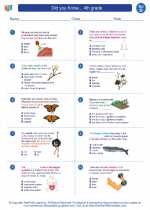Did you Know... 4th grade -> nucleus
Nucleus
The nucleus is a membrane-bound organelle found in eukaryotic cells. It is often referred to as the control center of the cell because it contains the cell's genetic material and is responsible for regulating the cell's activities.
Structure of the Nucleus
- The nucleus is typically spherical or oval in shape.
- It is surrounded by a double membrane called the nuclear envelope, which contains tiny openings called nuclear pores that allow for the exchange of materials between the nucleus and the rest of the cell.
- Inside the nucleus, there is a gel-like substance called nucleoplasm, which contains various structures including the nucleolus and chromatin.
Functions of the Nucleus
The nucleus performs several important functions, including:
- Storage of Genetic Material: The nucleus contains DNA, the genetic material of the cell, which is organized into structures called chromosomes. This DNA carries the instructions for the cell's development, growth, and reproduction.
- Transcription: The nucleus is the site of transcription, the process by which the information stored in DNA is copied into a molecule called messenger RNA (mRNA).
- Ribosome Production: The nucleolus, a structure within the nucleus, is involved in the production of ribosomes, which are essential for protein synthesis.
- Regulation of Cell Activities: The nucleus regulates the activities of the cell by controlling the expression of genes and coordinating various cellular processes.
Study Guide
Here are some key points to remember about the nucleus:
- What are the main components of the nucleus?
- What is the function of the nuclear envelope?
- Where is the genetic material stored in the nucleus?
- What is the role of the nucleolus?
- How does the nucleus regulate the activities of the cell?
Understanding the structure and functions of the nucleus is crucial for grasping the fundamental processes of cell biology. Make sure to review these concepts and ask questions if you need further clarification.
.◂Science Worksheets and Study Guides Fourth Grade. Did you Know... 4th grade
Study Guide Did you Know... 4th grade
Did you Know... 4th grade  Worksheet/Answer key
Worksheet/Answer key Did you Know... 4th grade
Did you Know... 4th grade  Worksheet/Answer key
Worksheet/Answer key Did you Know... 4th grade
Did you Know... 4th grade  Worksheet/Answer key
Worksheet/Answer key Did you Know... 4th grade
Did you Know... 4th grade 

 Worksheet/Answer key
Worksheet/Answer key
 Worksheet/Answer key
Worksheet/Answer key
 Worksheet/Answer key
Worksheet/Answer key

The resources above cover the following skills:
Core Ideas for Knowing Science
Life Science
Organisms are organized on a cellular basis and have a finite life span.